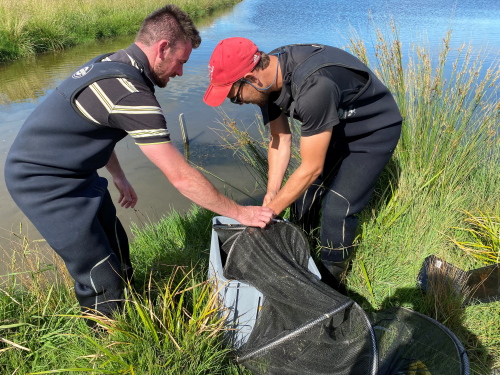
Current filter:

It’s only taken two years for a healthy native fish populations to build up in the Waikahu constructed wetland at Waitangi Regional Park.
The 15 hectare wetland was built in 2018 through a partnership between Hawke’s Bay Regional Council, Te Wai Mauri Trust, Ngāti Kahungunu Iwi Inc and Napier Port to boost habitat for freshwater fish and birdlife.
Regional Council staff found tuna hinahina (shortfin eel), tuna kuwharuwharu (longfin eel), and inanga. They also found fish that are great kai for wading birds like bittern including common bully, gambusia (mosquitofish), tadpoles, and goldfish.
Regional Council Freshwater Ecology Technician Andrew Horrell says the results are a step in the right direction to increasing wetland habitat in Hawke’s Bay.
“We’ve lost over 95% of our wetlands in Hawke’s Bay, and results like this show that if we can create some habitat, the fish will find it pretty quickly and make it their home,” says Mr Horrell.
This is part of ongoing monitoring of the wetland which will give the Regional Council a long-term picture of the benefit of the wetland.
Regional Council Team Leader Schemes Antony Rewcastle says part of the challenge with creating Waikahu Wetland was providing migratory fish a way in there, as its two meters above the Tūtaekurī River.
“We designed a fish pass that mimicked a small stream, with resting pools for fish to migrate into the wetland, and it’s great to see from the results that it is working as designed,” says Mr Rewcastle.
Regional Council Open Spaces Development Manager Rod Dickson says as well as fish, birds have also set up camp in the wetland.
“There’s a wonderful assortment of wetland bird species at Waikahu that are doing really well. As well as a full range of ducks, teal, dabchicks and scaup, species such as Royal spoonbill (Kotuku ngutu papa) have been nesting on the lake, and critically endangered species such as Bittern (Matuku) are present. Even migrant species such as the white winged black turn have been spotted visiting the site.”
“These species are also helped by predator control groups from Forest and Bird Napier and Waitangi Shooters Association who regularly check traps. By reducing the number of mustelids (ferrets, stoats and weasels), feral cats, hedgehogs and rats the birds have a much better chance of survival and nesting success.
“It’s really special is to see an area of what was once grazed farmland turn into a thriving biodiversity hotspot,” adds Mr Dickson.
Te Wai Mauri director Te Kaha Hawaikirangi says Waikahu wetlands focused on restoring the mauri of our awa by providing new habitat for mahinga kai and taonga species.
“Two years on from the creation of the wetland we are blown away by its success, it’s great to see the fruits of the mahi blossom. Poipoia te kakano kia puawai.”
27 January 2022
Disclaimers and Copyright
While every endeavour has been taken by the Hawke's Bay Regional Council to ensure that the information on this website is
accurate and up to date, Hawke's Bay Regional Council shall not be liable for any loss suffered through the use, directly or indirectly, of information on this website. Information contained has been assembled in good faith.
Some of the information available in this site is from the New Zealand Public domain and supplied by relevant
government agencies. Hawke's Bay Regional Council cannot accept any liability for its accuracy or content.
Portions of the information and material on this site, including data, pages, documents, online
graphics and images are protected by copyright, unless specifically notified to the contrary. Externally sourced
information or material is copyright to the respective provider.
© Hawke's Bay Regional Council - www.hbrc.govt.nz / +64 6 835 9200 / info@hbrc.govt.nz